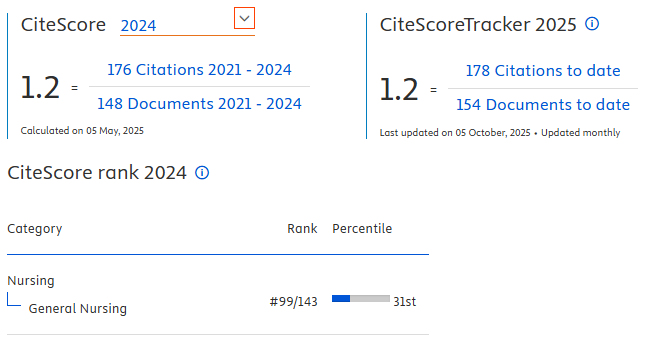Related Factors of a Nurse Handover Implementation in the Inpatient Ward of Ulin Hospital, Banjarmasin
Downloads
Introduction:Ideally, a handover is carried out through three stages: preparation, implementation, and post-handover. However, some handovers only consist of one phase. The aim of the study was to identify and analyze the factors related to the implementation of nurse handover.
Methods: This was a correlative analytic research method with a cross-sectional approach. The population in this study was all of the nurses with at least a Diploma III inpatient ward education. The sample totaled 174 nurses in the inpatient ward of Ulin Hospital Banjarmasin, recruited through proportionate stratified random sampling. The data was collected by spreading the questionnaire and the data collection took place from December 2017 to January 2018.
Results: There was a correlation between education level (p= 0.036) and role model (p= 0.021) with the implementation of handover. The most dominant factor associated with the implementation of handover was role model (p= 0.031: OR= 6.089).
Conclusion: The nurses who had a good role model performed th handover 6.089 times better than the nurses with an inadequate role model. Adversely, a poor role model might result in a poor handover.Bandura. (1971). bandura_sociallearningtheory.pdf. New York: General Learning Press.
Dewi, M. (2012). Pengaruh pelatihan timbang terima pasien terhadap penerapan keselamatan pasien oleh perawat pelaksana di RSUD Raden Mattaher Jambi. Jurnal Health and Sport, 5(03).
Hidayat, A. A. (2008). Pengantar Konsep Dasar Keperawatan.Cetakan Ketiga. Jakarta: Salemmba Medika.
Ihsan, F. (2007). Dasar-Dasar Kependidikan. Jakarta: Rineka Cipta.
Lankford, M. G., Zembower, T. R., Trick, W. E., Hacek, D. M., Noskin, G. A., & Peterson, L. R. (2003). Influence of role models and hospital design on the hand hygiene of health-care workers. Emerging Infectious Diseases, 9(2), 217.
Nursalam. (2014). Manajemen Keperawatan Aplikasi Keperawatan Profesional Edisi 4, 342.
Nursalam. (2015). Manajemen Keperawatan: Aplikasi dalam Praktik Keperawatan Profesional (Edisi 5). Jakarta: Salemba Medika.
Organization, W. H., & others. (2007). Communication during patient hand-overs. Patient Safety Solutions, 1(3), 1–4.
Permenkes RI. (2011). No. 1691 Tentang Keselamatan Pasien Rumah Sakit.
Safitri, R. (2012). Pengaruh Teknik Komunikasi SBAR Terhadap Motivasi dan Kepuasan Perawat Dalam Melakukan Operan di Ruang Rawat Inap RSUP Dr. M. Djamil Padang, 1–12.
Triwibowo, C., & Harahap, Z. (2016). Studi Kualitatif: Peran Handover dalam Meningkatkan Keselamatan Pasien di Rumah Sakit. Jurnal Pena Medika, 6(2), 72–79.
Triwibowo, C., Harahap, Z., & others. (2016). Studi Kualitatif: Peran Handover dalam Meningkatkan Keselamatan Pasien di Rumah Sakit. Pena Medika Jurnal Kesehatan, 6(2).
Vrischa T, M. (2015). Analisis Faktor-faktor yang mempengaruhi timbang terima di rruang rawat inap Rumah Sakit Grha Kedoya Jakarta Barat. Biomass Chem Eng, 49(23–6), 22–23.
Authors who publish with Jurnal Ners agree to the following terms:
- Authors transfer the Copyright and grant Jurnal Ners the right of first publication with the work simultaneously licensed under a Creative Commons Attribution 4.0 International License that allows others to remix, adapt and build upon the work with an acknowledgment of the work's authorship and of the initial publication in Jurnal Ners.
- Authors are permitted to copy and redistribute the journal's published version of the work (e.g., post it to an institutional repository or publish it in a book), with an acknowledgment of its initial publication in Jurnal Ners.
Jurnal Ners requires a formal written declaration and transfer of copyright from the author(s) for each article published. We, therefore, ask you to complete and return this form, retaining a copy for your own records. Your cooperation is essential and appreciated. Any delay will result in a delay in publication. The form can be downloaded HERE.
































